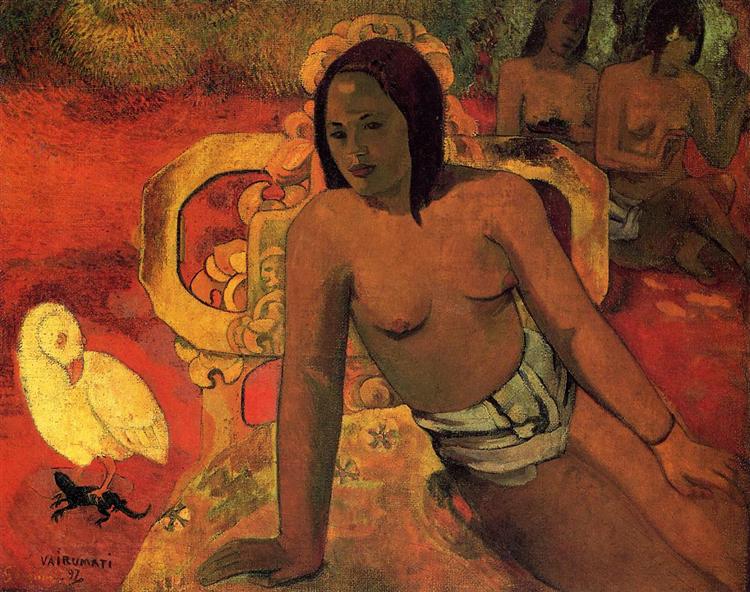Description
The work "Vairumati" by Paul Gauguin, made in 1892, is a vivid testimony of the artist's Polynesian period and a lesson on the symbolism and aesthetics of his compositional elections. In this painting, Gauguin introduces us to a world full of emotion and mystery, where its use of color and shape become vehicles of cultural and personal interpretation.
In the center of the composition, the female figure, which is identified as Vairumati, stands out with an almost mystical presence. The shape of his body, stylized and monumental, is represented with bold and simple strokes that contrast with the complexity of the background elements. His position and the direction of his gaze suggests a narrative that invites the viewer to explore the relationship between the figure and its surroundings. Vairumati's gaze, directed to the left, suggests introspection and connection with a world that is beyond the physical.
Gauguin uses a palette of vibrant and saturated colors, with predominance of the terracotta, green and blue tones that evoke the wealth of the Polynesian landscape. This use of color not only serves to create an exuberant atmosphere, but it is also a manifestation of the deep emotions that the artist associates with the culture and spirit of Tahití. The choice of these colors resonates with Gauguin's philosophy to seek the truth through the senses, breaking with the conventions of the European palette, in an attempt to capture the essence of life on the island.
The background of the paint, with its dense vegetation and exotic trees, frames the figure of Vairumati, suggesting an organic connection between the human being and nature. This relationship is fundamental in Gauguin's work that is often perceived as a desire to return to a state of purity and simplicity, an ideal that finds its reflection in the indigenous cultures that explores. The use of simplified forms and the absence of excessive details reinforce this idea, allowing the viewer to focus on the emotional essence of the work.
"Vairumati" is also an example of the symbolism that characterizes Gauguin. The figure not only represents a Tahitian woman, but is erected as a symbol of femininity, nature and tribal spirit. Gauguin had a complex fascination for the myth and symbolism that represented the culture of the Pacific Islands and sought to transmit it through his works. This painting can be interpreted as a visual poem in which each element has a cultural and emotional resonance, which makes it a central piece of its artistic legacy.
Although "Vairumati" is not as well known as other works by Gauguin, such as "El Dream" or "La Primavera", its place in the chronology of his work and his exploration of deep themes make it an important point of the evolution of his evolution of his evolution style. This work, along with others from his Polynesian series, shows his tireless search for a new form of expression, moving away from European impressionism to embrace a more personal and symbolic language.
In sum, "Vairumati" is much more than a simple representation of female beauty; It is an emotion translated into color and shape, a reflection of Gauguin's fascination by Tahitian culture, and a testimony of his desire to capture something deeper than superficial. The work invites the viewer to contemplate the complex interrelation between the human figure and the natural environment, opening a dialogue about the search for identity and cultural connection. With his magic and mystery, "Vairumati" remains a gesture of the unwavering relationship between art and soul.
KUADROS ©, a famous paint on your wall.
Hand-made oil painting reproductions, with the quality of professional artists and the distinctive seal of KUADROS ©.
Reproduction service paintings With a guarantee of satisfaction. If you are not completely satisfied with the replica of your painting, we refund your money 100%.

